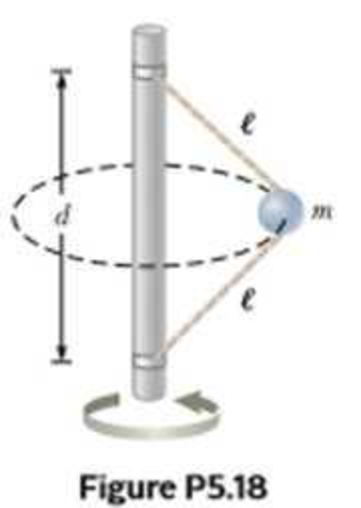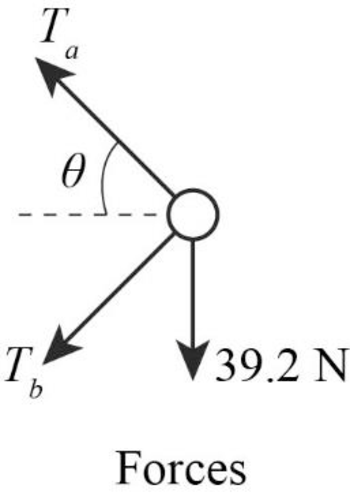
Why is the following situation impossible? The object of mass m = 4.00 kg in Figure P5.18 is attached to a vertical rod by two strings of length ℓ = 2.00 m. The strings are attached to the rod at points a distance d = 3.00 m apart. The object rotates in a horizontal circle at a constant speed of v = 3.00 m/s, and the strings remain taut. The rod rotates along with the object so that the strings do not wrap on to the rod. What If? Could this situation be possible on another planet?

The reason why the situation shown in Figure P5.18 is impossible, and whether this situation is be possible on another planet.
Answer to Problem 18P
The situation shown in Figure P5.18 is impossible, because the speed of the object is too small, the lower string is require that act like a rod and push rather than like a string and pull. This situation is only possible when
Explanation of Solution
The free body diagram of the system is shown Figure.

Write the expression for force due to gravity.
Here,
A centripetal force is needed to keep the object in the circular motion, this is equal to the force in the horizontal direction.
Here,
From the free body diagram, write the expression for net force in the
Here,
Equate equation (II) and (III).
Write the expression for force in the
Since there is no acceleration in the
From the free body diagram, write the expression for net force in the
Equate equation (V) and (VI).
Add equation (IV) and (VII).
Conclusion:
The angle
`
The radius of the orbit can be found as follows,
Substitute,
Substitute,
It indicates that lower string pushes rather than pulls.
Substitute,
Substitute,
This is possible only when
Therefore, the situation shown in Figure P5.18 is impossible, because the speed of the object is too small, the lower string is require that act like a rod and push rather than like a string and pull. This situation is only possible when
Want to see more full solutions like this?
Chapter 5 Solutions
Bundle: Principles of Physics: A Calculus-Based Text, 5th + WebAssign Printed Access Card for Serway/Jewett's Principles of Physics: A Calculus-Based Text, 5th Edition, Multi-Term
- 12. What is the angle between two unit vectors if their dot product is 0.5?arrow_forwardIf the car in the previous problem increases its power output by 10% (by pressing the gas pedal farther down), at what rate will the car accelerate? Hint: Consider the net force. In the previous problem the power was 31.8kWarrow_forwardWhat power is required (at the wheels) for a 1400 kg automobile to climb a 4% grade at a constant speed 30 m/s while it is opposed by drag and rolling resistance forces totaling 500 N?arrow_forward
- No chatgpt pls will upvotearrow_forwardAs a box is lifted against gravity and placed on a shelf, how does the work done by the lifter compare with the work done by gravity? What is the net work done on the box? What does this imply about its change in kinetic energy? Use definitions and mathematics from this chapter to answer these questions.arrow_forwardAs I carry a box up a flight of stairs, am I doing positive work or negative work on the box? Provide a mathematical explanation.arrow_forward
- Air temperature of 37 °C increases swimming pool temperature of 2.55 °C. What is the fraction of the water in the pool must evaporate during this time to carry enough energy to keep the temperature of the pool constant? 4186 J/(kg°C) = specific heat of water 2,430,000 (2.43 x 106) J/kg = latent heat of vaporization for the water in the pool.arrow_forwardThe iceberg requires 7.4 x 1020 Joules of energy to melt it completely. It absorbs energy from the Sun at a constant average rate of 88 Watts/m2. The total surface area of iceberg exposed to the sunlight is 12 billion (1.2 x 1010) square meters. How long will it take for sunlight to melt the entire iceberg in yearsarrow_forward1.0 kg block of ice to melt in the kitchen. The temperature in the kitchen is 31 °C. The ice starts out at 0 °C and takes an hour to melt and reach the same temperature as the surrounding room (31 °C). How much heat does the 1.0 kg of ice/water absorb from the room as it melts and heats up to 31 °C in Joules absorbed? Latent heat of fusion for water/ice is 334,000 J/kg Specific heat of water is 4186 J/kg°Carrow_forward
 Physics for Scientists and Engineers with Modern ...PhysicsISBN:9781337553292Author:Raymond A. Serway, John W. JewettPublisher:Cengage Learning
Physics for Scientists and Engineers with Modern ...PhysicsISBN:9781337553292Author:Raymond A. Serway, John W. JewettPublisher:Cengage Learning Principles of Physics: A Calculus-Based TextPhysicsISBN:9781133104261Author:Raymond A. Serway, John W. JewettPublisher:Cengage Learning
Principles of Physics: A Calculus-Based TextPhysicsISBN:9781133104261Author:Raymond A. Serway, John W. JewettPublisher:Cengage Learning University Physics Volume 1PhysicsISBN:9781938168277Author:William Moebs, Samuel J. Ling, Jeff SannyPublisher:OpenStax - Rice University
University Physics Volume 1PhysicsISBN:9781938168277Author:William Moebs, Samuel J. Ling, Jeff SannyPublisher:OpenStax - Rice University Physics for Scientists and EngineersPhysicsISBN:9781337553278Author:Raymond A. Serway, John W. JewettPublisher:Cengage Learning
Physics for Scientists and EngineersPhysicsISBN:9781337553278Author:Raymond A. Serway, John W. JewettPublisher:Cengage Learning Physics for Scientists and Engineers: Foundations...PhysicsISBN:9781133939146Author:Katz, Debora M.Publisher:Cengage Learning
Physics for Scientists and Engineers: Foundations...PhysicsISBN:9781133939146Author:Katz, Debora M.Publisher:Cengage Learning Glencoe Physics: Principles and Problems, Student...PhysicsISBN:9780078807213Author:Paul W. ZitzewitzPublisher:Glencoe/McGraw-Hill
Glencoe Physics: Principles and Problems, Student...PhysicsISBN:9780078807213Author:Paul W. ZitzewitzPublisher:Glencoe/McGraw-Hill





